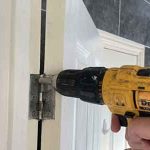If you are planning to repaint the door frames and doors in your property, you will need to sand and prepare the woodwork first.
Before you apply any paint, it is important that the surface is ready to receive a new coat of paint. By taking your time to prepare correctly, you will ensure the best possible finish.
When there are a lot of doors to sand, you may be wondering the quickest and easiest way to do the work. Obviously, manual sanding with sandpaper is an option, but you may want to speed up the process with an electric sander, or some other type of tool.

The best tool for the job, will largely depend on the thickness of the existing paint and the current state it is in. For example:
- Old door frames and doors with thick layers of paint – In this case, your best option is removing the bulk of the paint with a heat gun, then finishing the surface by sanding. This can be done manually, or with an electric sander.
- Thin layers of flaky, old paint – This won’t be as tough, and you can use a sanding block with some sandpaper. If you want to speed up the process, an orbital sander, or a detail sander will do the best job.
- Thin paint in good condition – If the door frames and doors are in reasonably good condition, then a light sand is recommended. Again, sandpaper and a sanding block is sufficient. However, you can opt for an orbital or detail sander if you want to save time.
Best tool for removing thick paint
When it comes to removing thick paint from door frames, a sander is probably not the best tool initially. It will take far too long to remove, and you will end up going through lots of sanding pads, as they clog up with old paint.
Two popular options for removing thick paint, are chemical paint strippers, or a heat gun. Both will soften the paint, allowing it to be scraped off much more easily.
The cheapest and fastest option is stripping the paint with a heat gun. This is especially true if you are stripping multiple door frames, doors, and other woodwork.
You can pick up a decent heat gun for £20-£30. In comparison, a budget paint stripper will cost around £10 per litre. In general, one litre will strip around one square meter, and the thicker the layers, the less effective this will be.
As you can see, paint stripper can get very expensive, very quickly, and it’s not even as good as a heat gun.
You can buy a heat gun and a scraper, plus a detail sander for around £50-£60 and this will do a far better job in less time.
The process for removing thicker paint is relatively simple. Just use the heat gun to soften the paint, then remove with a scraper. Once the bulk of the paint is removed, you can fill any holes, cracks, and gaps with a wood filler and sand to a smooth finish.
Following this, you can dust the door with a clean paint brush to remove any dust and dirt. Then once it is clean, you can give it a quick wash down with some sugar soap and a damp cloth.
Leave to dry for 10-15 minutes and you’re ready to start decorating.
Recommended tools for stripping and sanding thick paint
Completing this work doesn’t need to cost a fortune. You can get some really good affordable tools for stripping and sanding thick paint.
Below you can see our recommended tools for this job:
- Black and Decker KX1650-GB Heat Gun – Click here to learn more
- Black and Decker 55W Mouse detail sander – Click here to learn more
- Heavy-Duty Stainless-Steel Paint Scrapers – Click here to learn more
As we mentioned previously, you don’t have to use a power sander. A sanding block and sandpaper will do the job. It will just take a little longer and some extra effort. If you already have sandpaper and don’t mind the extra work, then this will be fine.
Best sander for old flaky paint
If your door frames and your doors have thin flaky paint, then a heat gun won’t be necessary. In this instance, you simply need to remove any loose paint, then sand down to a smooth surface for painting.
Any flaking and loose paint should be easily removed with a scraper. Once this has all been removed, you can brush the dust from the surface and proceed to fill any holes or gaps in the surface.
Following this, you can sand down your door and door frame manually with sandpaper. Or you can use a detail sander.
If you do opt for an electric sander, then we would recommend the same black and decker sander we mentioned in the previous section.
The shape of this sander, makes it handy for getting into tight spots, such as the corners and rebates of your door frame. As well as any moulding in the door itself.
It can even be used effectively to sand detailed mouldings in skirting and architrave around the door.
You can see this sander again and read hundreds of reviews by clicking here
Once sanded, you can clean away any dust and give the door a damp rub down with some sugar soap prior to painting.
Best sander to lightly sand door frames and doors
In this scenario, the process of sanding is simply to provide a key for new paint. For gloss, this will mean removing the sheen of the existing paint and creating a lightly scratched surface, suitable for the new paint to bind to.
You will need to follow the same steps for any filling that is required. However, the sanding should only be light. You are not trying to remove paint. You are simply trying to create a good surface for a new coat.
Realistically, this could be done with a sanding block and sandpaper. However, if you do want to speed up the process, you can still use an electric sander, like the Black and Decker we mentioned previously.
Just be aware, you don’t want to sand too much and remove the paint down to the bare wood. Just go lightly and use a higher grit fine sandpaper for the best results.
Cleaning the door prior to painting can be done exactly the same as the previous two examples.
Conclusion
So there you have it, the best sander for door frames and doors will vary based on the level of paint removal required. However the process for each is largely the same. The only difference is a slight variation in the tools required for each job.
The good news, is the job is relatively easy as a DIY project, and the tools for the job won’t break the bank.




